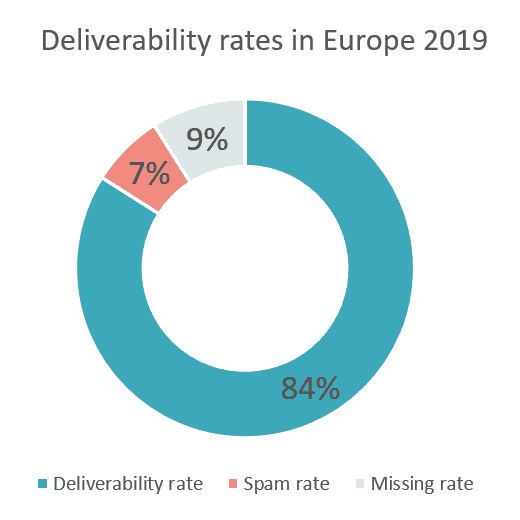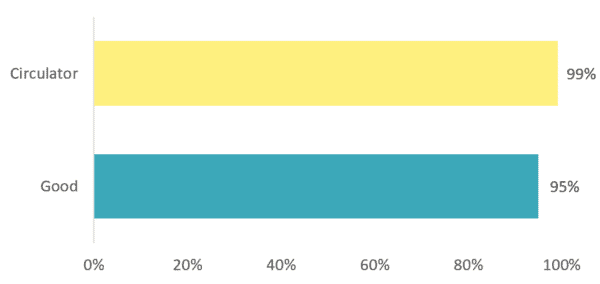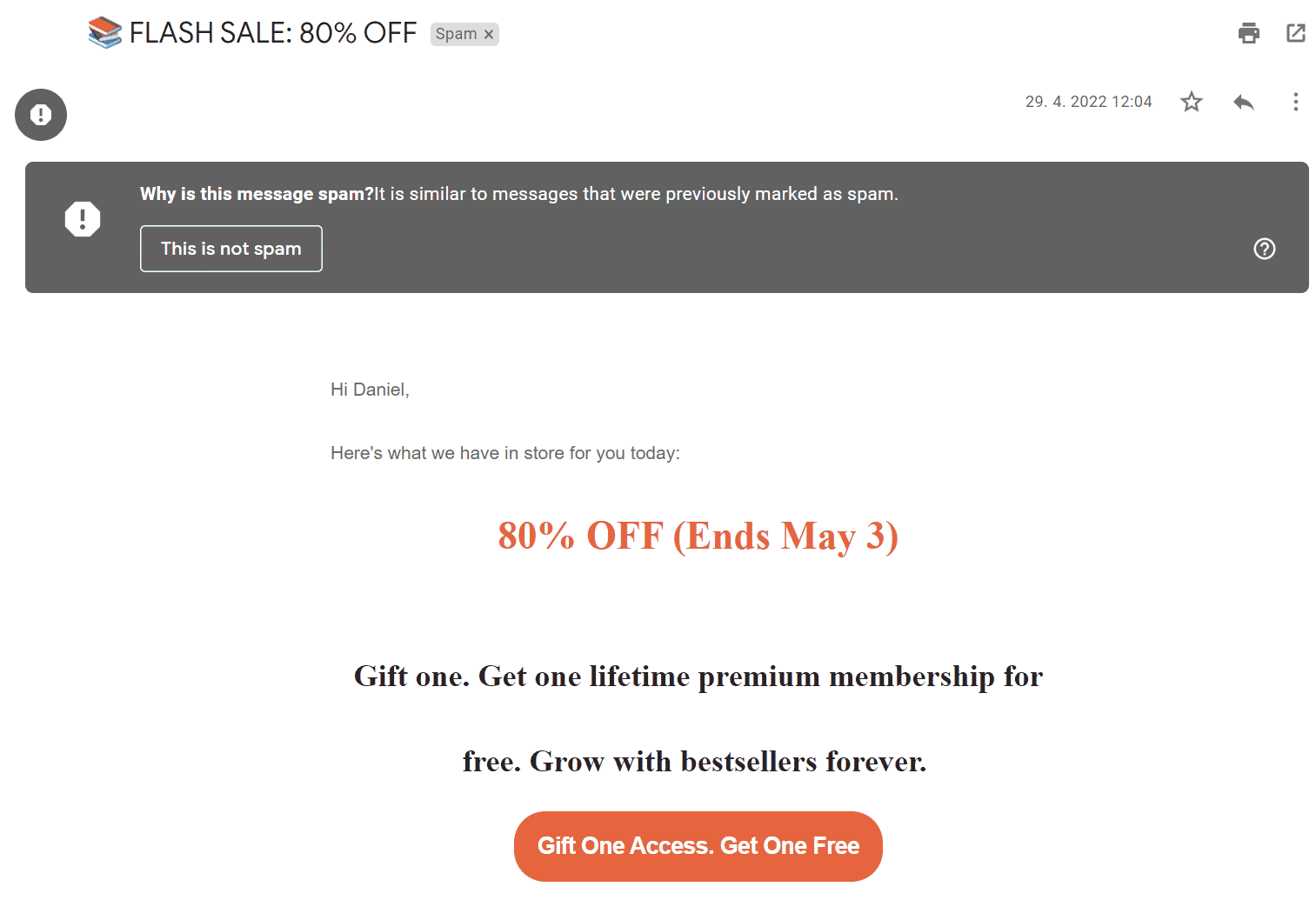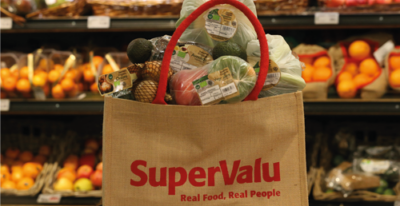
How To Improve Email Deliverability – 7 Effective Ways
How To Improve Email Deliverability – 7 Effective Ways
Email deliverability is an important metric that can significantly impact your overall email marketing performance. In this article, you will learn about email deliverability and how to improve it to achieve the best marketing results.
What is email deliverability?
First, we must understand the difference between email delivery and deliverability. If your email reaches the user’s inbox, we talk about email delivery.
Email deliverability depends on where your emails land and how many of your contacts receive your email. The deliverability rate measures the percentage of your emails successfully reaching users’ inboxes while avoiding the spam folder and not being rejected (bounced). The higher the percentage is, the better the chance of users opening and reading your messages.
On the other hand, bounce rate tells us the percentage of email addresses that did not receive messages since their email server returned them.
Why does email deliverability matter?
Email deliverability is one of the most important factors for your campaign’s success and it should be the first issue to address. If your messages are not delivered, you’re losing the opportunity to connect with your customers and it’s just as if they were never on your list in the first place.
A low deliverability rate can also negatively affect your open and click rates, and your deliverability issues could gradually worsen even more over time.
What are good deliverability rates?
Generally, a 95% or higher is considered a good deliverability rate. However, most marketers struggle to achieve such a number, and it often fluctuates between 88-99%. (Omnisend). However, according to a research conducted by Validity, in 2019, the deliverability rate in Europe was only 84%, while the spam rate was 6%, and 9% of messages were missing.

Circulator follows the best deliverability practices and its clients across all industries see an average deliverability rate of 99%.

What affects email deliverability?
There are many factors affecting email deliverability that you should pay attention to. Read below the most common factors that impact email deliverability.
1) Sending reputation
Your sending reputation typically combines the sending source (sender’s IP and sending domain) and your sending history and past behaviour. It concerns the sending volume and the number of emails that were considered suspicious for several reasons. For example, if users tag your emails as spam, that contributes negatively to your sending reputation.
2) Message content
The content plays an important role when it comes to deliverability. Emails are automatically scanned, including your headlines, images and URLs. If suspicious activity is detected, your email may end up in the spam folder. There are also categories of emails that have a higher chance of being rejected by email servers. These are typically emails concerning dating sites, finance, pharmaceuticals, etc.
3) Email infrastructure and permissions
Proper authentication is needed to diminish the risk of your email ending up in the spam folders. Also, sending emails to contacts outside of your email list can result in many bounces and can increase your spam rate. This can subsequently lead to a ban on your domain.
4) Sending frequency changes
Sudden and significant changes in your sending volume can also impact your deliverability rate as the number of emails will likely substantially increase. This can worsen your overall sending reputation and your email marketing results.
How to improve email deliverability
1) Build your sender’s reputation
Your behaviour and how users respond to you influence deliverability the most. While building a good sender’s reputation takes time, you can still take certain steps to help the process. It all starts with establishing a legitimate sender identity through standard identification methods.
We will go through the most important authentication methods and protocols that can help you establish a better sender reputation.
SPF and DKIM protocols
SPF (Sender Policy Framework) and DKIM (DomainKeys Identified Mail) are the two main authentications that allow you to establish your identity. Without having them in place, you put yourself at the risk of being blocked or tagged as spam by internet service providers.
SPF is a standard authentication method used to identify the authorisation of your sending server through DNS (Domain Name System) zone associations, which allows more granular control of DNS components. Implementation of SPF makes it harder for fraudsters to spoof sender information.
To use SPF, the IP addresses authorised for use must be published. The recipient’s server checks if the IP address is on your list. If not, emails sent from your server can be considered unauthorised and sent to spam.
In order to implement the SPF protocol, you need to:
– Gather IP addresses used to send emails and create an SPF record listing all your authorised servers
– Publish your SPF record to DNS
– Test
Source: Ongage
DKIM is used to verify the sender’s identity and protects your email from being turned into spam and virus messages. It adds an encrypted lock to your emails which cannot be relocked after the email is opened. If the key matches, the email will be delivered to your user’s inbox. If not, it will go automatically to spam. Many internet service providers automatically block emails without DKIM signatures.
To implement DKIM:
- Configure DKIM to generate the key pair
- Place public key as a TXT record in DNS settings
- Generate and save signature
Source: Mailjet
DMARC and BIMI authentications
DMARC (Domain Message Authentication and Conformance) works with SPF and DKIM. It communicates what authentication protocols you have in place and how to handle emails if verification fails. Emails that fail a DMARC authentication can be approved, quarantined or rejected.
To implement DMARC:
- Have SPF and DKIM protocols in place
- Add a new TXT record in DNS
Source: Ongage
BIMI (Brand Indicators for Message Identification) is another authentication method verifying that it is really you who is sending the messages. Essentially, BIMI displays your company logo alongside your authenticated email messages and helps you build trust and a stronger brand. It can also prevent phishing and spoofing.
Learn more about BIMI and its implementation in our dedicated article.
Email domain validation
Email domain validation verififies weather the email address is real ot fake. It delves into checking a domain’s mail exchange (MX) record.
You can use the Check MX Google Admin Toolbox that can help you find problems with your domain configuration. Below, you can find some of the tool checks points:
- Domain should have at least 2 NS servers
- Naked domain must be an A record (not CNAME)
- SPF must allow Google servers to send mail on behalf of your domain
- MX lookup must fit in one UDP response packet
Source: Spiralytics
2) Send emails only to people who gave you permission
Emails should be sent only to people who voluntarily gave you their permission and are interested in receiving messages from you. Therefore, make sure to include email opt-in in your sign up form, which must also be compliant. If you send emails only to contacts in your email list, the chances of ending up in your users’ spam folders are minimal.
3) Provide a preference centre
Preference centres allow users to choose which emails they are interested in and receive the most relevant content. You can also enable users to decide how frequently they want to receive your emails. This generally results in higher engagement and subsequently in better deliverability rates.
4) Improve your content
If you want most of your emails to be delivered without any problem, you should pay extra attention to the content of your messages. There are several aspects that can worsen or improve your deliverability rate:
Avoid using large images
Having too many large images can cause longer loading times for your emails, so they can eventually end up deleted or in a spam folder
Keep emails concise and to the point
Even though your business is legit, your emails can be marked as spam if you use too many trigger words. Here’s an example of an email ending up in the spam folder because the email used spammy words and was similar to messages that were previously marked as spam:
Don’t use spammy words in your subjects lines
- Spammy words, such as ‘Free’, ‘Best price’, etc. are often automatically detected by ISPs as trigger words and such emails can be marked as spam messages
- Avoid using exclamation marks and ALL CAPS
- Do not use deceptive subject lines and false promises
- Do not use too many emojis

5) Increase sending volume gradually
If you’re growing your email list, increase the sending volume gradually. Don’t change it by 50 or more per cent in a matter of days. Thus you can avoid having too many messages in spam folders and maintain a good sender reputation.
Here’s an example of how you can gradually increase your sending volume from 10,000 to 50,000 without putting your sending reputation at risk:

6) Make it easy to unsubscribe
You should give your customers an option to unsubscribe from your email if they’re no longer interested in receiving your content. This way, you can prevent them from tagging your emails as spam, and your sending reputation will remain intact.
7) Use a good email service provider
Having a good service provider can certainly improve your deliverability rate. In Circulator, we set up our clients’ accounts with all necessary authentications, and provide clients with advice and best practices and do regular account reviews to make sure they stay on the right track and get the highest possible deliverability rates.
We also put together an article on email deliverability for insurance brokers. Click on the link to learn more!
Please don’t hesitate to contact us if you’re looking to improve your deliverability rate. Our team of experts will be happy to assist you.
Learn more about Circulator’s products here.
You can also take a look at how we help our clients achieve outstanding email marketing results.






